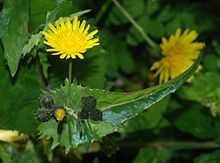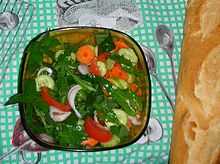Sonchus oleraceus
| Common sowthistle | |
|---|---|
 | |
| Scientific classification | |
| Kingdom: | Plantae |
| (unranked): | Angiosperms |
| (unranked): | Eudicots |
| (unranked): | Asterids |
| Order: | Asterales |
| Family: | Asteraceae |
| Tribe: | Cichorieae |
| Genus: | Sonchus |
| Species: | S. oleraceus |
| Binomial name | |
| Sonchus oleraceus L. | |
Sonchus oleraceus (common sowthistle,[1] sow thistle,[2] smooth sow thistle, annual sow thistle, hare's colwort, hare's thistle, milky tassel, swinies) is native to Asia and Europe. The Latin name Sonchus refers to the hollow stem, while oleraceus refers to its good taste.[3] The common name sow thistle refers to its attractiveness to swine, and the similarity of the leaf to younger thistle plants. The common name hare's thistle refers to its beneficial effects and attractiveness for hare and rabbits.[citation needed]
Botanical characteristics
Prefers full sun, and can tolerate most soil conditions. The flowers are hermaphroditic, and common pollinators include bees and flies. It spreads by seeds being carried by wind or water.
This plant is considered an invasive species in many parts of the world, where it is found mostly in disturbed areas.[4][5]
Nutritive qualities
Leaves are eaten as salad greens or cooked like spinach. This is one of the species used in Chinese cuisine as kŭcài (菜; lit. bitter vegetable).[6] Blanching or boiling removes bitter flavour.
Nutritional analysis[7] reveals 30 – 40 mg of vitamin C per 100g, 1.2% protein, 0.3% fat, 2.4% carbohydrate. Leaf dry weight analysis per 100g (likely to vary with growing conditions) shows: 45g Carbohydrate, 28g protein, 22g ash, 5.9g fibre, 4.5g fat; in all, providing 265 calories.
Minerals
Calcium: 1500 mg
Phosphorus: 500 mg
Iron: 45.6 mg
Magnesium: 0 mg
Sodium: 0 mg
Potassium: 0 mg
Zinc: 0 mg;
Vitamins
A: 35 mg
Thiamine (B1): 1.5 mg
Riboflavin (B2): 5 mg
Niacin: 5 mg
B6: 0 mg
C: 60 mg
Herbalism
Sonchus oleraceus has a variety of uses in herbalism.[7] It also has been ascribed medicinal qualities similar to dandelion and succory.[8]
Control
This plant can often be controlled by mowing, because it does not regrow from root fragments.[5] Attempts at weed control by herbicide, to the neglect of other methods, may have led to proliferation of this species in some environments.[9]
References
| Wikimedia Commons has media related to Sonchus oleraceus. |
- ↑ Sonchus oleraceus at USDA PLANTS Database
- ↑ Sonchus oleraceus at Plants For A Future
- ↑ http://www.arthurleej.com/a-sowthistle.html
- ↑ Sonchus oleraceus at Center for Aquatic and Invasive Plants
- ↑ 5.0 5.1 Sonchus oleraceus L., Asteraceae, Pacific Island Ecosystems at Risk (PIER)
- ↑ "Kucai". Baidu Encyclopedia (苦菜_百度百科) (in Mandarin). baike.baidu.com. Retrieved 2008-02-07.
- ↑ 7.0 7.1
- ↑ "A Modern Herbal | Sow-Thistles". Botanical.com. Retrieved 2013-01-16.
- ↑ "Management of common sowthistle | Agriculture, Fisheries & Forestry | Queensland Government". Dpi.qld.gov.au. 2012-08-16. Retrieved 2013-01-16.
External links
- Annual Sow-thistle (Sonchus oleraceus) Photos, Drawings, Text. (Wild Plants of Winnipeg from Nature Manitoba)
